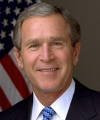The Decline of a President: Tracing Bush’s Approval Ratings in the Upper Midwest

A Smart Politics study of nearly 180 public opinion polls conducted between 2004 and 2008 in the region finds Bush’s decline into one of the least popular Presidents in U.S. history to have basically bottomed out in 2007. The story of his second term plays out almost uniformly across Iowa, Minnesota, and Wisconsin.
Bush ended his first term in 2004 – nationally and in the region – with approval ratings just north of mediocre, and that was good enough (against a John Kerry candidacy) to not only win re-election but also the state of Iowa (and nearly pull out a victory in Wisconsin). Bush’s average approval ratings in 2004 were 52 percent in Wisconsin, 50 percent in Iowa, and 47 percent in Minnesota.
As the war in Iraq continued, Bush experienced a large drop in his approval ratings in the early months of his second term. By May 2005, Bush had already dropped to 39 percent in Iowa and 42 percent in both Minnesota and Wisconsin. For the year, Bush’s marks fell to an average rating of 43 percent in Minnesota, 41 percent in Wisconsin, and 40 percent in Iowa – an average 8.5-point drop in the region compared to 2004.
Despite Republicans losing control of both the U.S. House and Senate in 2006, as well as 4 U.S. House seats and 3 state legislative chambers in the Upper Midwest, Bush’s approval ratings held fairly consistent from 2005 to 2006. Bush’s average marks for the year only fell to 40 percent in Wisconsin, and 39 percent in Iowa and Minnesota – just a 2-point average drop across the three states.
Bush’s 7th year in office, however, proved to be a difficult sell as the U.S. death toll in Iraq continued to mount while economic concerns grew stronger. Bush’s average yearly rating fell sharply to just 33 percent in Wisconsin, 32 percent in Iowa, and 31 percent in the Gopher State – a 7.3-point average drop in the region.
But in the first 7 months of 2008, Bush’s average marks have only dipped slightly – down to 31 percent in Iowa and Wisconsin and to 30 percent in Minnesota – just a 1.7-point average decline.
Explanations as to why Bush’s approval ratings seem to have stabilized are many. Although the Bush administration is currently facing significant domestic problems relating to jobs, the housing market, and energy, most matrices indicate the situation in Iraq has at long last stabilized, if not improved. While many Democrats do not believe this to be the case, their skepticisim would have no impact on Bush’s numbers: most Democrats had all but abandoned Bush within a year after the launch of the Iraq War.
Alternately, it could be argued that the only demographic left supporting Bush after 2007 was the staunchest of conservative Republicans – lifelong GOP-ers who would stick by their President in the face of almost any news. Bush has therefore not so much won back independents and moderate Republicans as he has maintained the support of a large percentage of his conservative base.
Thirdly, due to the 2008 campaign, President Bush has been able to largely remain on the sidelines throughout much of the year, while the country focused its attention first on the Barack Obama/Hillary Clinton battle and now the fight for the presidency between Obama and John McCain.
It is therefore unlikely, though not impossible, for Bush to leave office in January 2009 with Upper Midwest job approval ratings in the 20s.
